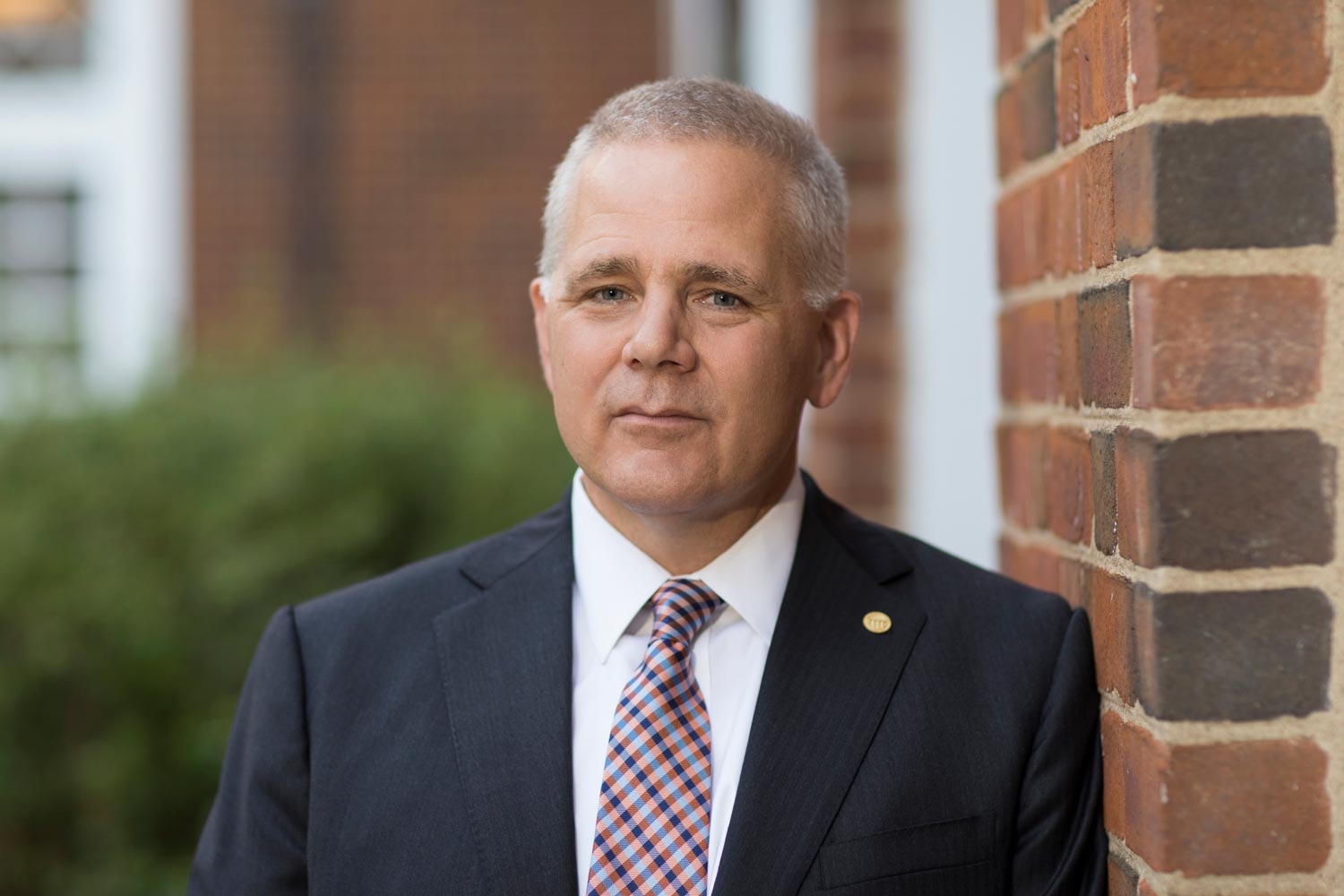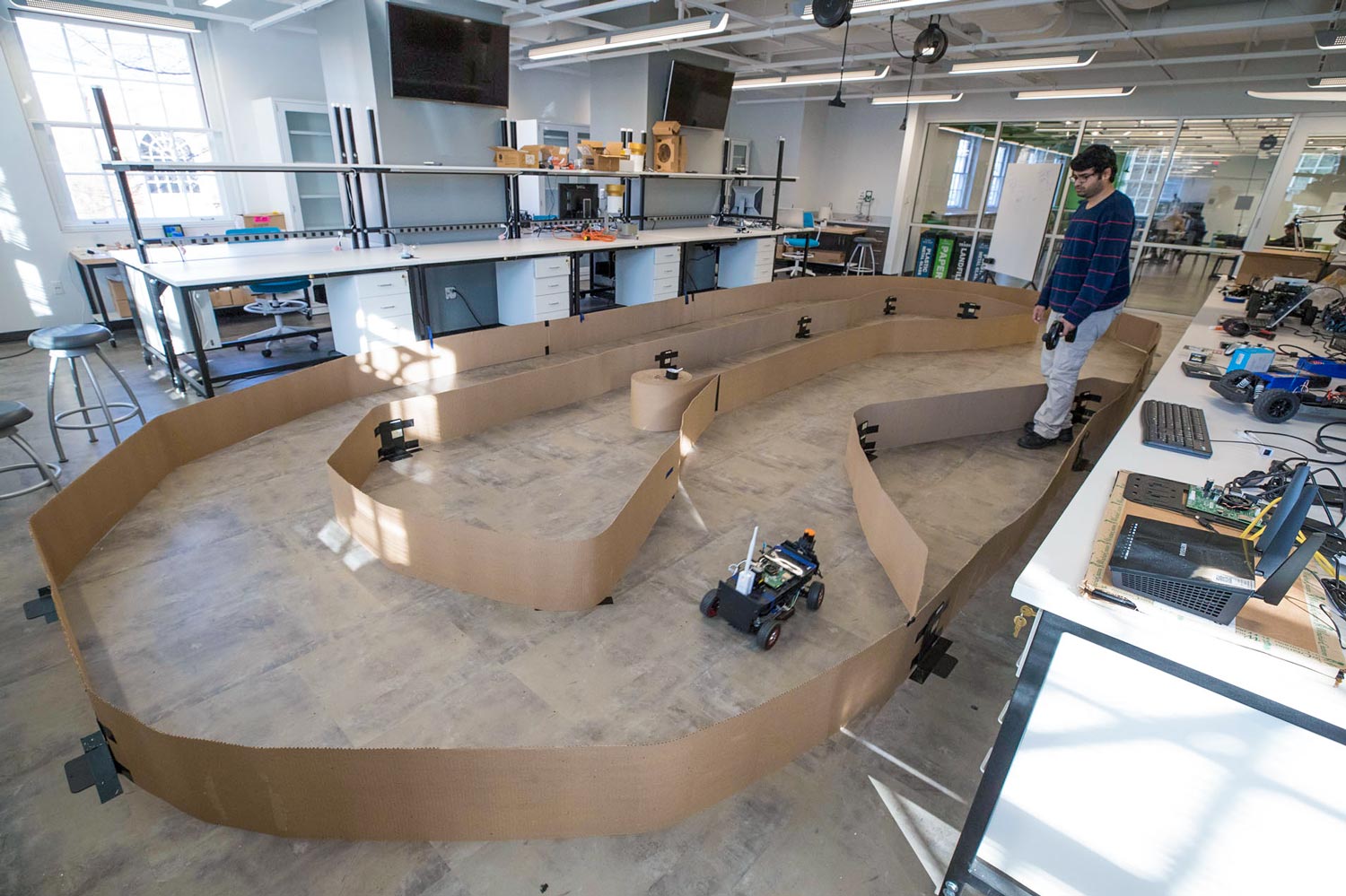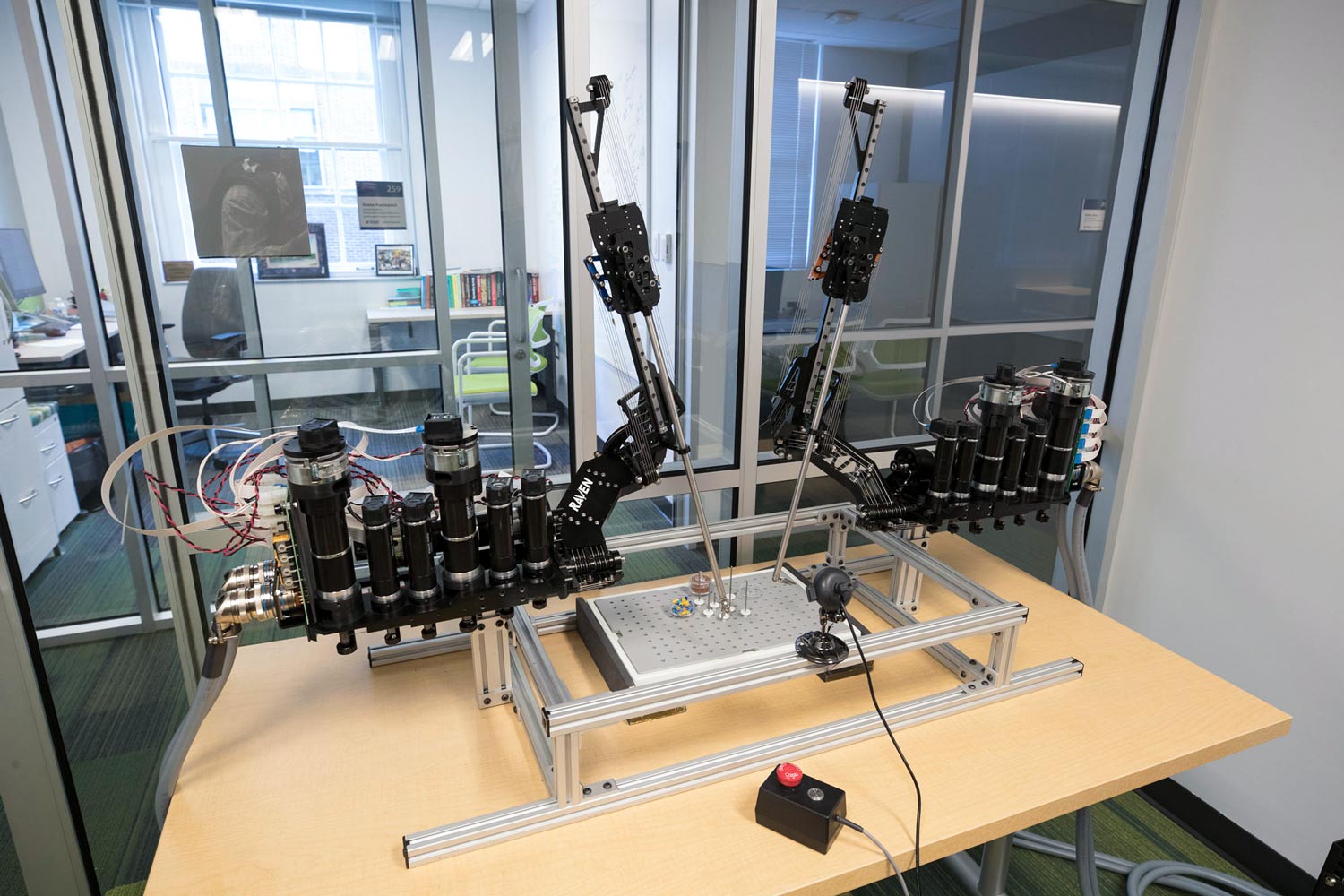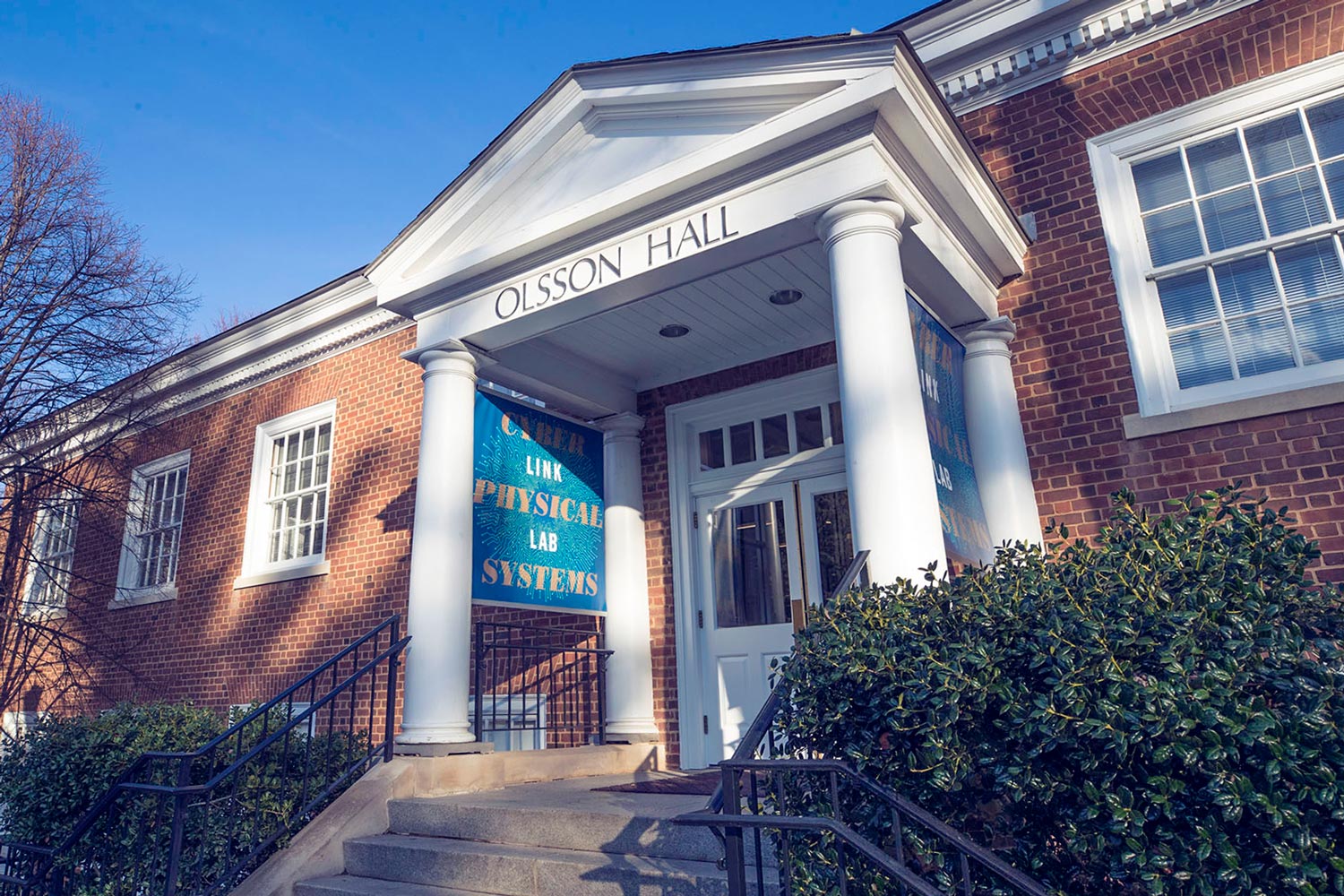In the not-too-distant future, roadways will be filled with driverless vehicles. Robots will help surgeons operate more precisely and safely. Homes will sense how their occupants want to live, and adjust systems to make it happen.
The University of Virginia School of Engineering & Applied Science’s new Link Lab, opening Thursday in a space that occupies the entire top floor of Olsson Hall, will bring these new technologies to life. The lab is a 17,000-square-foot space where researchers will develop and deploy systems that link the cyber and physical worlds, such as autonomous cars, smart buildings and technology-driven health care.
Cyber-physical systems are defining technologies of the 21st century. In October 2015, UVA Engineering announced its cyber-physical systems initiative and its intent to build the Link Lab to bring together researchers from across the Engineering School and the University with expertise in a variety of technologies and their applications. High on the list of priorities is cyber security, keeping the increasing numbers of networked systems reliable and secure.
Educating students who can become leaders of the cyber-physical systems of the future is also a priority. Computer Science Professor John A. Stankovic, Link Lab director, makes that point in a 2016 National Academy of Sciences report he co-authored, “A 21st Century Cyber-Physical Systems Education.”
The lab was one of the first projects supported by UVA’s Strategic Investment Fund, with $4.8 million to build the space and house a collaborative team of more than 30 faculty members and more than 100 graduate students.

Dean Craig Benson
UVA Engineering Dean Craig Benson talked with UVA Today about the Link Lab and the vision for UVA’s leadership in cyber-physical systems.
Q: Cyber-physical systems is a relatively new field. Why do scientists and engineers think it will be critical in the 21st century?
A: Everything in our future is going to be connected through the internet – everything in the world in which we work and spend our lives. Cyber-physical systems is the link between computers, data, decision-making and the physical world, and cyber-physical systems let us do things in a much faster, more efficient and effective way.
Autonomous vehicles are a great example of this. Imagine you’re in a car that’s driving you down the highway at 60 miles an hour. That car is a physical system. You’re just riding in the car, with not a care in the world, and it’s catapulting down the road with all the other cars around it. The computer system in that car has to constantly measure where those other cars are, where the roadway is, how the weather might be affecting everything. It’s gathering all that data, organizing it, processing it, understanding what it means, and sending it back out to the physical system – the car – to tell it how to adjust and react and get where it’s going without crashing. All of this is happening in real time, with somebody else’s vehicle one second in front of you, and another vehicle one second behind you. The whole thing is being run by a cyber-physical system. That’s pretty amazing.

Small, autonomous vehicles navigate their way around a Link Lab track as their larger counterparts would on a real highway.
What we do today in advanced manufacturing is quintessential cyber-physical systems. UVA is a founding member of the Commonwealth Center for Advanced Manufacturing near Richmond, and we’re partnered with big companies like Rolls-Royce and Arconic to bring new technologies to industry. One advancement was to automate the process of taking big pieces of metal and cutting them on lathes into specialty parts for aeronautics. It used to take a long time to hand calibrate the lathes, and now it’s all done in a matter of seconds with computerized systems.
Another example of a cyber-physical system is a smart home. Today, we have new tools like intelligent thermostats and apps that let you control your house lights with your smartphone. In the future, you’re going to walk into your home, and it’s going to adjust all the systems for you based on data it has collected and analyzed about how you live. Your home will control the heating, air, lights and other systems. It will all be done in the background without you having to think about it.
If you think about all of this from the perspective of sustainability and improving human quality of life, cyber-physical systems will help us to manage our lives and our environments with an exceptional degree of precision. It will be a whole new world.
Q: What do you see as the particular strengths and areas of expertise UVA can bring to the development and deployment of cyber-physical systems?
A: Here at UVA, we have faculty and students across the University working in multiple areas of cyber-physical systems. They are generally organized around three research themes: autonomous systems, such as driverless cars; smart cities, which include things like smart buildings; and intelligent health. That’s really important. How can we use cyber-physical systems to better monitor patients’ conditions and deliver highly precise, highly effective care?
At UVA we’ve got this unique ecosystem with a strong medical school, a strong hospital, and strong schools of engineering, nursing, business, law, arts and sciences, architecture and public policy, all within walking distance of each other. Our Link Lab faculty and their students are involved with colleagues in projects across those disciplines. We’ve got experts in algorithms, sensors, computations, systems and applications, and the nexus is an advantage for UVA.
When we announced in 2015 that we would pursue cyber-physical systems as an initiative for research and education, we made a very conscious decision that for this to be effective, we needed to co-locate our scholars and students. The Link Lab is all about creating an environment where scholars and students can work together on real-world problems. We’re going to develop solutions that will really help people and drive the economy. And while we’re doing that, we will educate leaders who can tackle challenges we don’t even know about yet.
I’m proud that we’ve established ourselves as national leaders just a couple of years after focusing around cyber-physical systems.
Q: Were you concerned that people outside UVA Engineering would not understand the power and potential of cyber-physical systems for society?
A: All you have to do is think about one day of your life with your smartphone, and you realize this is going to be mainstream in a few years. Your smartphone is a cyber-physical system – you touch a screen, the phone connects to the world, and suddenly you can buy things from Bangkok.
Industry’s goal is that one day soon, when you dream of something you need, you order it online and the item is delivered to your home via drone within 30 minutes. This will only be accomplished with cyber-physical systems. I never had any doubt that our cyber-physical systems initiative was going to be critical to the future of the nation’s competitiveness.
Most people who have been involved in the private sector understand this immediately. In nearly every corporate strategic plan today, cyber-physical systems and automation are right at the top. Their ability to actualize and operationalize those systems are critical to their business success. They either do this well, or they’re going to get creamed in the market.
I was reading an article recently about textile manufacturing. The United States used to have a robust textile manufacturing economy, but it all moved overseas due to the high cost of labor here. Now, automation is reaching those overseas textile manufacturers, which in turn removes the competitive advantage of cheap labor. We can bring those textile industries right back to the United States, where we are competitive in the development and deployment of automated systems.
Q: What is most exciting to you about the formation of the Link Lab?
A: I believe the Link Lab is the future of higher education, when students and faculty will work and learn together in open, collaborative spaces. UVA is leading the way, thanks to the Board of Visitors’ investment in the Link Lab through the Strategic Investment Fund.
The space allows faculty and students to thrive in an environment that’s moving and growing and continuously evolving. Students are learning from faculty, and faculty are learning from students.
It’s not traditional higher education. It’s a model of what higher education around the world is going to be in the future, and it’s a heck of a lot of fun.
Q: When you arrived at UVA in 2015, you and the Engineering School faculty began working right away to generate new ideas for research and education, such as the cyber-physical systems initiative and the Link Lab. What will be the next big things?
The really big things on the horizon are what we’re doing between engineering and medicine. This is so important to our prosperity and quality of life as a society.
My mom had cancer at the end of her life. For three years, she battled the cancer with chemotherapy, and it was horrible. Most of us have stories about family members and friends who have endured medical traumas, because we just do not know enough yet about how to make medicine predictive and proactive. It’s so inexact right now. We have to be able to solve the problems of disease in a more precise way.

In a combination of medicine and engineering technologies, robots will be more fully assisting in surgeries.
At UVA, we’re bringing the engineering, the science and the practice of medical care together so we have a high degree of confidence that treatments are going to work. For example, UVA’s artificial pancreas project, which is on the cusp of revolutionizing treatment for diabetes, is based on algorithms developed by Professor Stephen Patek, a systems engineer. Professor Kevin Janes, one of our biomedical engineers, is working on models of cellular behavior. He has whole new ideas about how cancer cells behave that are going to perhaps revolutionize how we think about cancer. Armed with that new knowledge, we can rethink how we deliver cancer treatment, so when we give chemotherapy, we know precisely how it is going to affect the cancer cells and we know what the precise outcome will be. This will be a game changer. We will be able to give people confidence and quality of life that we can’t even imagine right now.
We are providing engineering expertise for these medical challenges, and it’s one of the most important things we’re going to be able to do.
Media Contact
Article Information
February 21, 2018
/content/whats-uvas-new-link-lab-future

